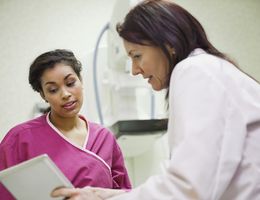Health library
Back to health libraryBreast cancer screening

When breast cancer is found early, a woman has the greatest range of treatment options and the greatest likelihood of successful treatment.
When it comes to breast cancer, early detection saves lives. That's why it's important to stay on top of recommended screenings, including:
Mammogram. Talk to your doctor about your risk for breast cancer and the screening schedule that’s best for you. Women at average risk for breast cancer can begin mammogram screenings at age 40. For women at high risk, it may be best to start even sooner.
According to the American Cancer Society (ACS), women ages 45 to 54 who are at average risk should have a mammogram every year. At 55, they may choose to switch to every other year, and the ACS recommends that women continue to get mammograms as long as they are healthy and expect to live at least 10 more years.
Mammograms are specialized x-rays of the breast that can reveal tumors before they can be felt. Many studies have shown that early detection saves lives and increases treatment options, according to the ACS. Today, most mammograms are digital. The images are saved as computer files instead of being on film. This allows a doctor to look at the x-ray image from different views or magnify sections for a closer look. Digital x-rays also allow doctors to view with greater accuracy potential areas of concern in women who have dense breasts.
Ongoing research is exploring how newer technologies can help make mammograms even more effective.
For example, breast tomosynthesis, or 3D mammography, may allow clearer views of breast tissue. In this type of x-ray, numerous images are taken as the machine moves over the breast. Then a computer puts the images together to create a 3D picture. Breast tomosynthesis may find more cancers and also reduce callbacks for more tests, some studies suggest.
Breast awareness. While the ACS no longer recommends clinical breast exams or breast self-exams, it is still important for women to be aware of how their breasts normally look and feel and to report any new changes to a healthcare professional right away.
Magnetic resonance imaging (MRI). In addition to a mammogram, women at high risk for breast cancer should have an MRI every year. Women with moderately high risk for breast cancer should discuss this screening test with their doctor.
An MRI uses magnetic fields to image breast tissue. This test can reveal some cancers that a mammogram would miss, but it is also more likely to reveal unusual tissue growth that isn't cancer. In women at average risk for breast cancer, this is more likely to lead to follow-up procedures for growths that aren't cancer, which carries its own risks. That's why screening with MRI is not recommended for all women.
Breast ultrasound. If something unusual shows up on a mammogram, a breast ultrasound test may show if the mass is solid or filled with fluid. A solid mass could be cancer. Breast ultrasound may also be helpful in addition to mammograms for women who have dense breasts and an increased risk of breast cancer, according to the ACS.
Ultrasound can also be helpful if a woman's breasts are very dense, which can make it difficult to get a clear mammogram picture. Some doctors also use ultrasound to see if the edges of a tumor are smooth or ragged. Cancerous tumors more commonly have ragged edges.
Determining your risk
According to the ACS, a woman is at high risk for breast cancer if she has:
- A known BRCA1 or BRCA2 gene mutation.
- A first-degree relative (mother, father, brother, sister or child) with a BRCA1 or BRCA2 gene mutation.
- A history of chest radiation therapy between ages 10 and 30.
- Li-Fraumeni syndrome, Cowden syndrome, Bannayan-Riley-Ruvalcaba syndrome or a first-degree relative with one of these syndromes.
- A 20% to 25% or greater lifetime risk of breast cancer, according to risk assessment tools based mostly on family history.
Your doctor can help you determine your breast cancer risk.
Reviewed 3/28/2025
- American Cancer Society. "American Cancer Society Guidelines for the Early Detection of Cancer." https://www.cancer.org/healthy/find-cancer-early/american-cancer-society-guidelines-for-the-early-detection-of-cancer.html.
- American Cancer Society. "American Cancer Society Recommendations for the Early Detection of Breast Cancer." https://www.cancer.org/cancer/breast-cancer/screening-tests-and-early-detection/american-cancer-society-recommendations-for-the-early-detection-of-breast-cancer.html.
- American Cancer Society. "Breast Cancer Early Detection and Diagnosis." https://www.cancer.org/cancer/breast-cancer/screening-tests-and-early-detection.html.
- American Cancer Society. "Breast Cancer Signs and Symptoms." https://www.cancer.org/cancer/breast-cancer/screening-tests-and-early-detection/breast-cancer-signs-and-symptoms.html.
- American Cancer Society. "Breast MRI." https://www.cancer.org/cancer/breast-cancer/screening-tests-and-early-detection/breast-mri-scans.html.
- American Cancer Society. "Breast Ultrasound." https://www.cancer.org/cancer/breast-cancer/screening-tests-and-early-detection/breast-ultrasound.html.
- American Cancer Society. "Mammogram Basics." https://www.cancer.org/cancer/breast-cancer/screening-tests-and-early-detection/mammograms/mammogram-basics.html.
- National Cancer Institute. "Breast Health: Follow-up after an Abnormal Mammogram." https://www.cancer.gov/types/breast/breast-changes.
- National Cancer Institute. "Mammograms." https://www.cancer.gov/types/breast/mammograms-fact-sheet.
